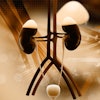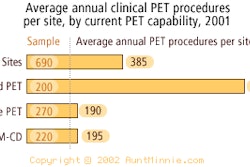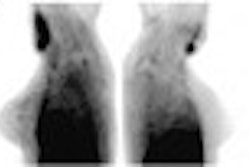BALTIMORE - Imaging specialists performing the standard technetium-99m sestamibi stress protocol may not need to wait three hours between tests to allow for the breakdown of sestamibi, according to a poster presented Thursday at the American Society of Nuclear Cardiology conference.
The three-hour delay is generally required between the rest and stress injections to allow for adequate decay of the radionuclide between the two exams. The results of this 119-patient study showed that a rapid protocol, following a low-dose rest injection and a higher-dose stress injection, can still produce good image quality and adequate detection of ischemia.
"The three-hour wait is terribly inconvenient for patients and bad for the pace of the laboratory," said lead author Dr. Howard Lewin from the University of California, Los Angeles (UCLA). The study was conducted at the San Vincente Cardiac Imaging Center, also in Los Angeles.
Patients were given the sestamibi injection, drank water, and waited an hour before the imaging exam started. Lewin and his team used a resting dose of 6-7 mCi of sestamibi at rest and 33-34 mCi of sestamibi for the exercise phase. The high dose used for the exercise phase was designed to help compensate for the lack of decay seen in the resting dose, the authors wrote. All imaging was performed on a dual-head gamma camera, without attenuation correction. The stress test immediately followed the rest test without any delay between the two exams.
A reader blinded to the results, as well as the clinicians, evaluated each patient for ischemia. The reader also assessed image quality on a five-point scale ranging from excellent (5) to unacceptable (1). Regional activity was determined by choosing familiar regions of interest (ROI) for all rest-stress image pairs. Relative activity (RA) was defined as the ration of stress ROI to rest ROI.
According to the results, the reader gave a grade of 4.1 for the quality of the images taken at rest, and a score of 4.0 for those acquired during the stress phase. The overall RA for the rest phase of both tests was 7.2.
The group found no significant differences in the results based on either stress or rest dose used or on patient weight, which ranged from 151-200 lb in the mostly older, male patients. And they reported excellent intraobserver correlation (p=0.92).
"This was a precursor to the next project, which I call the ultrafast protocol," Lewin said. This even speedier protocol would allow the resting image to be taken immediately after the sestamibi injection and water without the hour wait, he explained.
By Brian ReidAuntMinnie.com contributing writer
September 27, 2002
Related Reading
Real-time MR stress imaging detects cardiac wall-motion abnormalities, September 23, 2002
Dobutamine SPECT helps assess myocardial viability, August 19, 2002
Investigational cardiac stress agent begin phase III trial, July 30, 2002
Copyright © 2002 AuntMinnie.com




















